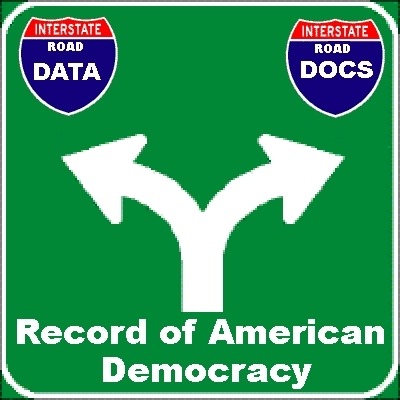The Record Of American Democracy (ROAD) data includes election returns, socioeconomic summaries, and demographic measures of the American public at unusually low levels of geographic aggregation. The NSF-supported ROAD project covers every state in the country from 1984 through 1990 (including some off-year elections). One collection of data sets includes every election at and above State House, along with party registration and other variables, in each state for the roughly 170,000 precincts nationwide (about 60 times the number of counties). Another collection has added to these (roughly 30-40) political variables an additional 3,725 variables merged from the 1990 U.S. Census for 47,327 aggregate units (about 15 times the number of counties) about the size one or more cities or towns. These units completely tile the U.S. landmass. The collection also includes geographic boundary files so users can easily draw maps with these data.
A PDF version of this documentation (omitting several large tables) is provided below. The full documentation is available in the ROAD dataverse.
And for those eager to get started...
Available Data
ROAD data is generally available for 1984-1990. In some cases, data we were unable to locate are missing. There are two frequently used types files available on the ROAD site:
- MCD group level data: This is voting, registration and census data aggregated to Minor Civil Division groups. MCD groups are designations made by the US Census. Typically, they have the same population as a small city.
- Precinct level data: This is voting data and registration data (where available) aggregated to voting precinct level. Voting precincts (sometimes also known as voting districts) are determined by the Registrar of Voters in whatever county the precinct resides. Typically, they have the same population as a group of city blocks. This is the lowest level of aggregation available on the ROAD site.
MCDs group level data is merged with the census data, and therefore has a wealth of demographic information. Precinct level data is not merged with the census, but is at a finer level of aggregation.
Downloading Data
Use the download links on the data pages to download individual files in their native formats (generally SPSS portable, and ascii), or the checkboxes to download multiple files at once. To download data in other formats or to run analyses on line use the [Subsetting/Statistics] button next to each data file.
A naming system identifies the data found in a file. For example, the file "mg_ak.por" contains the 1984-1990 MCD files for Arkansas. The file "ak86mp20.por" contains the 1986 voting precinct file for Arkansas. In all cases, the data files are SPSS portable files and have a ".por" extension identifying them as such.
Data Definitions
Once you load the data into your favorite program, you will notice a naming convention exists for the variables. Variable names starting with "p" and "h" are census variables for persons and households. Variable names that start with "g" are electoral data. To understand the data definitions, please read the documentation .
In addition, a detailed list of frequently asked questions and answers is available
Limitations
The ROAD data were gathered by contacting the Registrar of Voters (or some local equivalent) for counties across the United States. Unfortunately, some counties do not retain records of all electoral information, thus some data has been lost to time. This understandably causes problems. We've identified these cases in an exceptions file. Please read the FAQ and documentations.
Citation
Gary King; Bradley Palmquist; Greg Adams; Micah Altman; Kenneth Benoit; Claudine Gay; Jeffrey B. Lewis; Russ Mayer; and Eric Reinhardt. 1997. ``The Record of American Democracy, 1984-1990,'' Harvard University, Cambridge, MA [producer], Ann Arbor, MI: ICPSR [distributor].
| ROAD_codebook.pdf | 1.97 MB |

